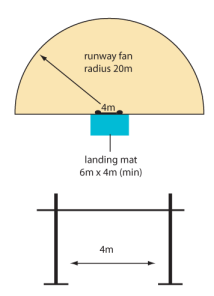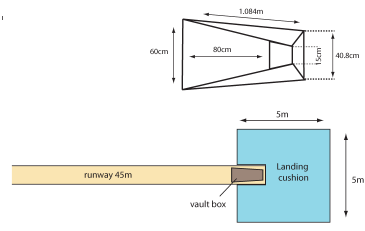Introduction
Track and field jumping events consist of four events: high jump, long jump, pole vault and triple jump.Long jump
The long jump is a jumping event where athletes combine speed, strength, and agility in a horizontal jump for distance. Jumpers make their approach down the runway at nearly top speed, plant a foot on the take-off board and leap into the air. A legal jump requires that no part of the forward foot extends beyond the board. The long jump facility includes a runway, take-off board and landing area.The runway for the long jump is 40m minimum and is measured from the beginning of the runway to the take-off line. The runway is 1.22m ± 0.01m and marked by white lines 5cm in width. The maximum lateral inclination of the runway is 1:100 and the overall inclination in the running direction is 1:1000.
The take-off board is marked by a board sunk level with the runway and the surface of the landing area. The take-off board is white, rectangular, made of wood or other suitable rigid material and measures 1.22m ± 0.01m long, 20cm ± 2mm wide and 10cm deep.
The edge of the board closest to the landing area is the take-off line. The distance between the take-off line and the far end of the landing area is at least 10m. The take-off line is placed between 1m and 3m from the nearer end of the landing area.
Immediately beyond the take-off line there is a plasticine indicator board or other suitable material for recording the athlete's footprint when he has foot-faulted. This board is 10cm (± 2mm) wide and 1.22m (± 0.01m) long and is painted in a contrasting colour to the take-off board. The board is mounted in a recess or shelved in the runway on the side of the take-off board near the landing area.
The upper part of the indicator board is covered for the first 10mm and along its entire length by a plasticine layer. The surface of the board beneath the plasticine is made of a material in which the spikes of an athlete's shoe will grip and not skid. When mounted in this recess, the whole assembly is sufficiently rigid to accept the full force of the athlete's foot.
The landing area has a minimum width of 2.75m and a maximum width of 3m. If possible, it is to be placed in the middle of the runway so that if extended, it would coincide with the middle of the landing area. The landing area is filled with soft, damp sand, the top surface of which is level with the take-off board.

Triple jump
The triple jump was previously known as the 'hop, step and jump', which describes the actions of the competitor. The athlete runs down a runway until he reaches a designated mark where the jump is measured. The first landing is done with the take-off foot. The next phase is a step, landing on the opposite foot, and is followed by the jump, into a sand-filled box, as in the long jump.Except for the placement of the take-off board, the same facilities are used for triple jump as for the long jump. It is recommended that the take-off board is not less than 13m for men and 11m for women from the nearer end of the landing area. For other competitions, this distance is appropriate for the level of competition.

High jump
The high jump is an event in which an athlete tries to propel his/her body over a bar that rests across two upright poles. The jumper must take off from one foot after an approach from any angle along a semi-circular runway. Three successive misses eliminates the jumper. The jumper who jumps the highest wins.The high jump facility includes a semi-circular runway, a take-off area, two uprights with a crossbar and a landing area.The semi-circular runway with a radius of at least 20m permits an approach from every direction. The runway and take-off areas are usually covered with the same surface as the track. The maximum overall inclination of the runway and take-off area is 1:250 in the direction of running. The landing area is placed so the athlete's approach is up the inclination.
The minimum landing area is 6m long x 4m wide and 0.7m high. It is important for the safety of high jumpers, so a suitable landing mat is used which allows absorption of the impact from the fall of the athletes and gives adequate resiience when compressed.

Pole vault
Pole vaulting is an event where a person uses a long, flexible pole (usually made either of fibreglass or carbon fibre) as an aid to leap over a bar. The pole vault facility includes a runway, a box for inserting the pole, two uprights with a crossbar and a landing area.The length of the runway is a minimum of 40m. The width is 1.22m ± 0.01m and marked by white lines 5cm in width. The maximum lateral inclination of the runway is 1:100 and the overall inclination in the running direction is 1:1000.
The take-off for the pole vault is a box constructed of fibreglass, metal or wood, preferably with rounded upper edges and sunk level with the runway. It is 1.084m in length measured along the inside of the bottom of the box, 60cm in width at the front end and tapering to 15cm in width at the bottom of the stop board. The length of the box at runway level and depth of the stop board are determined by the angle of 105° formed between the base and the stop board.
The base of the box slopes from runway level at the front end to a vertical distance below ground level of 20cm at the point where it meets the stop board. The box is constructed in such a way that the slides slope outwards and end next to the stop board at an angle of approximately 120° to the base.
If the box is constructed of wood, the bottom is lined with 2.5mm sheet metal for a distance of 80cm from the front of the box. The landing area measures not less than 5m long and 5m wide. The sides of the landing area nearest to the box are placed 10cm to 15cm from the box and slope away at an angle of approximately 45°.
